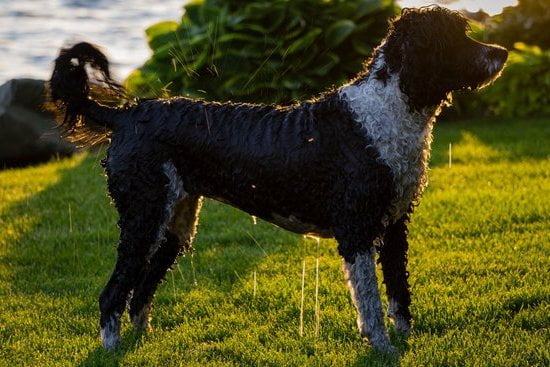Boxer dogs are known for their intelligence and energetic nature, making them a popular breed among dog owners. However, like any other dog, boxer dogs need to be properly trained in order to become well-behaved and obedient pets.
One essential aspect of training includes toilet training. In this article, we will explore the importance of toilet training for boxer dogs and provide you with a comprehensive guide on how to successfully train your boxer to relieve themselves in designated areas.
Toilet training is crucial for boxer dogs not only to maintain a clean and hygienic living environment but also for their overall health and well-being. By teaching your boxer where they should eliminate, you can prevent accidents from occurring inside your home and ensure that they understand the appropriate places to relieve themselves.
Understanding the breed-specific tendencies of boxer dogs is essential when it comes to toilet training. These dogs are highly intelligent and have a quick learning ability, which means that with consistent training methods they can grasp commands easily. Additionally, boxers are naturally clean animals with an instinctual desire to keep their living spaces tidy. Harnessing these instincts during toilet training can greatly facilitate the process.
By following the guidelines provided in this article, you will not only create a harmonious living space but also strengthen the bond between you and your boxer dog as you work together towards successful toilet training. Now let’s delve deeper into understanding the specific traits of boxer dogs in order to develop an effective toilet training plan tailored to their unique needs.
Understanding the breed
Boxer dogs are known for their intelligence and quick learning abilities, which can greatly facilitate the process of toilet training. Understanding the breed’s natural instincts is key to effectively teaching them where to go to relieve themselves.
One important characteristic of Boxers is their tendency towards cleanliness. They naturally prefer to keep their living areas clean and free from waste. This instinct can be harnessed during toilet training by providing a designated area where they can eliminate, such as a specific spot in your home or yard.
When choosing the right spot for your Boxer’s toilet area, consider accessibility and convenience for both you and your dog. It should be easily accessible so that you can quickly bring your Boxer there when they need to go. Additionally, it should be an area that is comfortable for your dog, with enough space for them to move around comfortably while eliminating.
To facilitate toilet training and create a controlled environment, many owners find it helpful to use a crate or playpen. This allows you to confine your Boxer when necessary, preventing accidents in other areas of the house while still giving them some freedom of movement within the designated space. Gradually extending this freedom as they become more reliably trained will help reinforce their understanding of where they should go.
In summary, understanding the natural instincts of Boxer dogs is crucial when toilet training them. Their intelligence and inclination towards cleanliness make them receptive learners in this process. By selecting an appropriate location and utilizing a crate or playpen, you can create a controlled environment that encourages success in their toilet training journey.
Setting up a designated toilet area
Choosing the right spot in your home or yard is crucial when setting up a designated toilet area. Look for an area that is easily accessible for both you and your dog. It should also be a location that is convenient and safe, away from high traffic areas or areas with potential hazards. A backyard or outdoor space is often preferred as it mimics the natural environment where dogs typically relieve themselves.
Using a crate or playpen can be beneficial when creating a controlled environment for your boxer’s toilet area. These tools help limit your dog’s access to other parts of the house while you are not able to directly supervise them. It also helps prevent accidents from occurring in areas where you do not want them to go.
Ensuring that the designated toilet area is comfortable and accessible is important in encouraging your boxer to use it consistently. Consider using materials such as gravel, mulch, or turf that are easy to clean and maintain. Additionally, provide easy access to the area by using gates or doors that your dog can easily navigate through.
By following these tips, you can effectively set up a designated toilet area for your boxer dog. This will create an environment that promotes consistent and successful toileting habits, enabling smoother progress in their overall toilet training journey.
| Tips for setting up a designated toilet area |
|---|
| Choose an easily accessible spot in your home or yard |
| Utilize a crate or playpen to create a controlled environment |
| Use materials that are easy to clean and maintain, such as gravel or turf |
| Provide easy access to the area using gates or doors |
Establishing a consistent routine
Firstly, it’s important to create a regular feeding and toilet schedule for your boxer. This means feeding your dog at the same time every day, which will help regulate their bowel movements and make it easier to anticipate when they will need to go outside. By taking your dog outside shortly after they’ve eaten, you can increase the chances of them going to the bathroom in the designated area.
Additionally, consistency in taking your boxer outside at specific times throughout the day is crucial. This includes first thing in the morning, before bedtime, after meals, and after playtime or exercise sessions. These regular potty breaks should be incorporated into their daily routine so that they understand when it’s time to go outside.
Positive reinforcement plays a significant role in encouraging successful toilet trips during this process. When your boxer relieves itself in the designated area, be sure to praise and reward them immediately afterwards. This can be done through verbal praise, petting, or offering a small treat as positive reinforcement. By consistently rewarding their good behavior, your dog will understand that using the designated area for toileting is highly desirable.
Incorporating these strategies into your daily routine will greatly contribute to successful toilet training for your boxer dog. Consistency helps reinforce their understanding of when and where they should go to relieve themselves, making it easier for them to develop good habits. By following a consistent routine, you’ll see progress with your boxer’s toilet training more quickly and effectively.
| Establishing a consistent routine | Tips |
|---|---|
| Create a regular feeding and toilet schedule | – Feed your dog at the same time every day \n – Take your dog outside shortly after they’ve eaten \n – Anticipate when they will need to go outside based on their feeding schedule |
| Take your boxer outside at specific times throughout the day | – First thing in the morning, before bedtime, after meals, and after playtime or exercise sessions \n – Incorporate regular potty breaks into their daily routine |
| Use positive reinforcement for successful toilet trips | – Praise and reward your boxer immediately after they relieve themselves in the designated area \n – Verbal praise, petting, or offering a small treat as positive reinforcement \n – Consistently reward their good behavior to reinforce understanding of desired toileting habits |
Supervision and monitoring
Keeping an eye on your boxer to prevent accidents
One of the key aspects of successfully toilet training a boxer dog is to provide constant supervision and monitoring. When you are in the process of training your boxer, it is important to keep a close eye on them at all times, especially during the initial stages. By doing so, you can prevent accidents from happening inside your home and reinforce positive behavior.
To effectively supervise your boxer, consider keeping them in the same room as you whenever possible. Use baby gates or closed doors to limit their access to certain areas where they may be more likely to have accidents. Additionally, consider using a leash indoors to have better control over your dog’s movements and quickly redirect them if necessary.
Identifying signs that your dog needs to relieve themselves
During the toilet training process, it is crucial to be able to recognize the signs that your boxer needs to go potty. This will help you take them outside at the appropriate times and prevent accidents inside. Some common signs that may indicate that your dog needs to relieve themselves include restlessness, sniffing around or circling a specific area, sudden stops during playtime or walking, and pawing at the door.
It’s important to remain patient and observant when looking for these signs as every dog may exhibit different behaviors. By watching their body language closely, you will gradually learn what cues indicate that they need a bathroom break.
Effective ways to redirect your dog if they are about to go in the wrong place
There may be instances where you catch your boxer in the act of trying to relieve themselves in an inappropriate area of your house. In such cases, it’s important not to punish or scold them as this can create anxiety and hinder their progress in toilet training. Instead, use redirection techniques by calmly calling their name or clapping gently. Once you have successfully redirected them, immediately take them to their designated toilet area where they can finish their business.
Consistency in redirecting your dog is key. By consistently and gently guiding them to the appropriate area, you will reinforce the desired behavior and make it easier for them to understand where they should go potty. Remember to give praise and rewards when they do use the correct spot, as positive reinforcement plays a crucial role in helping your boxer learn the appropriate bathroom behaviors.
House training techniques that work
Crate training as an effective method for toilet training
One of the most effective house training techniques for boxer dogs is crate training. Boxers are known to be den animals and naturally want to keep their living spaces clean. A crate can serve as a den for your boxer, providing them with a safe and comfortable space. When properly introduced, the crate can also be used as a valuable tool in toilet training.
Start by gradually introducing your boxer to their crate and making it a positive place for them. Place their favorite toys or treats inside the crate to encourage them to go in voluntarily. Allow your boxer to explore the crate at their own pace and never force them inside. Once they are comfortable entering the crate, you can start using it for toilet training.
Remember that puppies have limited bladder control, so it is important to take them outside frequently. Use the crate to establish a routine where your boxer goes outside after waking up, eating, drinking, or playing in order to reinforce proper elimination habits.
When you cannot directly supervise your boxer or when you’re unable to take them outside, put them in their crate. Dogs have a natural instinct not to soil their living area, so they will try to hold it until they are let out.
Utilizing the power of praise and rewards
Positive reinforcement is a crucial aspect of successful toilet training for any dog breed, including boxers. Whenever your boxer successfully eliminates in the designated toilet area, it is important to immediately reward and praise them.
Praise your dog enthusiastically with cheerful words such as “good job” or “well done” while petting and showing affection towards them. Additionally, offering small treats whenever they eliminate in the correct spot will associate that behavior with positive rewards.
It’s important not to punish or scold your boxer if they have accidents indoors. Punishment may create fear or anxiety around toilet habits and hinder their progress. Instead, focus on rewarding and reinforcing positive behavior. Consistently praising and rewarding your boxer for using the designated toilet area will reinforce their understanding of where they should eliminate and encourage them to continue doing so.
Introducing command words and using them consistently
Along with positive reinforcement, introducing specific command words can further aid in house training your boxer. Choose a simple word or phrase, such as “go potty” or “do your business,” that you consistently use when taking your boxer outside to eliminate.
Repeat the command word as your boxer is eliminating in the designated toilet area. Over time, they will associate the command word with the act of elimination. This can be particularly helpful when you’re traveling or in places where you don’t have easy access to a designated toilet area but still want to communicate to your boxer that it’s time for them to go.
Consistency is key when using command words. Always use the same phrase and say it in a clear and confident tone every time you take your boxer outside. Eventually, they will learn to associate the command word with the desired action and respond accordingly.
By implementing these house training techniques, such as crate training, utilizing positive reinforcement, and introducing consistent command words, you can effectively toilet train your boxer dog. With patience, persistence, and consistency, your boxer will become well-trained in no time.
Dealing with setbacks and accidents
When accidents occur, it is crucial to clean up properly to avoid lingering odors that can attract your boxer to the same spot again. In order to effectively remove odors, it is recommended to use an enzymatic cleaner specifically designed for pet stains and odors. These cleaners break down the organic components of urine or feces, eliminating the scent that might attract your dog back to the area.
In addition to cleaning up accidents, it is important not to punish your boxer for mistakes. Punishment can lead to fear and anxiety around toileting, which may complicate the training process. Instead, focus on redirection and positive reinforcement techniques. If you catch your boxer in the act of going in the wrong place, calmly redirect them to their designated toilet area using a cheerful tone of voice and guiding them with rewards such as treats or praise.
It is also worth noting that setbacks are bound to happen during toilet training. Your boxer may have accidents even after weeks or months of successful potty trips. Remember not to get discouraged – every dog learns at their own pace. Continue following consistent routines and providing supervision as needed, gradually giving your boxer more freedom as they demonstrate reliability in their toilet habits.
By understanding that setbacks and accidents are a normal part of toilet training, taking proper measures for cleaning and redirection, and remaining patient throughout the process, you will be well-equipped in dealing with any challenges that arise during this journey with your boxer dog.
Continuing the training process
Once your boxer dog has become comfortable with using the designated toilet area and has established a consistent routine, it is time to move forward with the training process. This section will provide guidance on transitioning from a controlled toilet area to allowing your boxer access to the whole house, maintaining consistent routines, and adjusting to new environments.
- Gradual freedom: Transitioning from a controlled toilet area to the whole house As your boxer becomes more reliable in using their designated toilet area consistently, you can gradually expand their freedom within the house. Start by giving them access to one room at a time, ensuring that they still have easy access to their designated toilet area.
Monitor them closely during this transition phase and be prepared to intervene if they show signs of needing to relieve themselves but can’t get outside in time. - Maintaining consistent routines as your boxer becomes fully trained Even as your boxer gains more freedom within the house, it is essential to maintain consistent routines for feeding and toileting. Continue taking them outside at specific times that align with their routine before gradually increasing the intervals between trips outside. Consistency is key in reinforcing good habits and preventing any setbacks.
- Tips for traveling with a toilet-trained boxer and adjusting to new environments If you plan on traveling or taking your boxer dog to new environments, it’s important to continue applying the same principles of consistency and routine. Bring familiar items such as their bed or toys along with you to create a sense of familiarity and comfort.
When staying in unfamiliar places, take extra care in introducing them to new designated areas for toileting so they can adjust accordingly.
Remember, each dog learns at their own pace, so be patient throughout the entire training process. Celebrate every accomplishment and milestone your boxer achieves during their journey towards becoming fully toilet trained. By following these tips and remaining persistent, you are setting up your boxer for success in maintaining good bathroom habits for a lifetime.
Conclusion
In conclusion, successfully toilet training your Boxer dog is an accomplishment that should be celebrated. Through patience, consistency, and positive reinforcement, you can train your Boxer to become a well-behaved and clean member of your household. By understanding the breed’s intelligence and tendencies towards cleanliness, you can tailor your training approach to suit their natural instincts.
Setting up a designated toilet area is crucial for successful training. Choose the right spot in your home or yard and create a controlled environment using a crate or playpen. Ensure that the toilet area is comfortable and accessible for your Boxer, making it more likely for them to choose it over other areas in the house.
Establishing a consistent routine is key in toilet training your Boxer. Create regular feeding and toilet schedules to help them develop a routine as well. Taking your Boxer outside at specific times will teach them where they should go potty. Remember to use positive reinforcement to encourage successful trips to the toilet area.
Supervision and monitoring are important during the training process to prevent accidents. Keep an eye on your Boxer and be aware of signs indicating that they need to relieve themselves. Effectively redirect them if they are about to go in the wrong place.
House training techniques such as crate training, praise, rewards, and consistent command words can all contribute to successful toilet training. Even with setbacks and accidents along the way, it is important to remain patient and persistent throughout the process.
As your Boxer becomes fully trained, gradually introduce freedom by transitioning from a controlled toilet area to allowing them access throughout the whole house. Maintain consistent routines even after they are fully trained to reinforce good habits.
Lastly, celebrating your successfully toilet-trained Boxer is important because having a well-trained dog has numerous benefits. Not only does it ensure cleanliness in your home but also strengthens the bond between you and your furry companion. Additionally, when traveling or introducing new environments, having a toilet-trained Boxer makes it easier to adjust and maintain good behavior.
Frequently Asked Questions
How long does it take to toilet train a Boxer?
The time it takes to toilet train a Boxer can vary depending on the individual dog and consistency in training. On average, it may take anywhere from a few weeks to several months. It is important to be patient and consistent during the process.
Start by setting up a routine for bathroom breaks, taking the puppy outside at regular intervals, such as after meals, naps, playtime, and first thing in the morning or before bedtime. Use positive reinforcement, such as treats and praise, when your Boxer successfully eliminates outside. Accidents are normal during the learning phase, so avoid punishment and focus on redirecting their behavior.
How do I stop my Boxer from peeing in the house?
To prevent a Boxer from peeing in the house, it is crucial to address any underlying causes that might be leading to this behavior. Firstly, ensure that your Boxer has been properly toilet trained using positive reinforcement techniques mentioned earlier. If accidents persist, check for potential medical issues that could be causing inappropriate urination and consult with a veterinarian if necessary.
Additionally, make sure your Boxer has ample opportunities for regular exercise and mental stimulation throughout the day as pent-up energy can increase accidents indoors. Establish a consistent feeding schedule and monitor their water intake closely. Keep an eye on signs like sniffing or circling that indicate your pup might need to eliminate soon.
What is the best way to potty train a Boxer puppy?
The best way to potty train a Boxer puppy is through consistency and positive reinforcement-based training methods. Begin by designating a specific area outside where you want them to eliminate consistently and bring them there frequently using a leash if needed. When they use that spot successfully, reward them with praise or small treats immediately after they finish eliminating. Develop a regular bathroom break routine that includes taking them out after meals or waking up from naps so they associate these times with going outside instead of indoors.
Supervise your puppy indoors at all times to quickly recognize any signs of needing to relieve themselves and promptly take them outside. If accidents happen, clean up without reprimanding or scolding the puppy as this may create confusion and anxiety. With consistent training and positive reinforcement, your Boxer puppy will learn to potty outside in due time.

Welcome to the blog! I am a professional dog trainer and have been working with dogs for many years. In this blog, I will be discussing various topics related to dog training, including tips, tricks, and advice. I hope you find this information helpful and informative. Thanks for reading!





